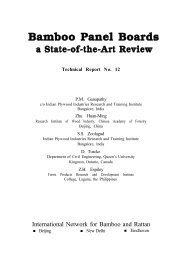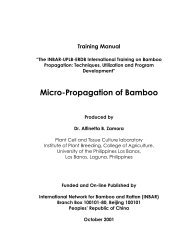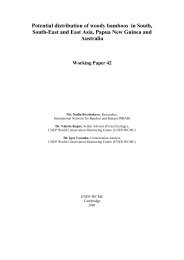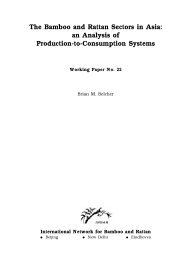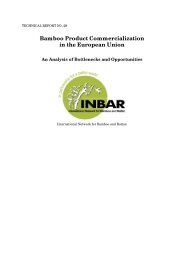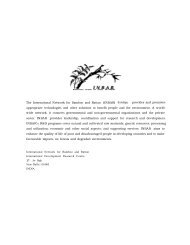ISSN ………… - International Network for Bamboo and Rattan
ISSN ………… - International Network for Bamboo and Rattan
ISSN ………… - International Network for Bamboo and Rattan
Create successful ePaper yourself
Turn your PDF publications into a flip-book with our unique Google optimized e-Paper software.
on wood chemistry (Browning 1952) 381 . Descriptions of wood <strong>and</strong> pulp analyses are found in different<br />
publications (Sieber 1951 19a ; Merck 1957 53 ; Rydholm 1965) 70 <strong>and</strong> also in the charts brought out by the<br />
professional associations of the Pulp Industry in various countries such as the USA (TAPPI St<strong>and</strong>ards),<br />
Sweden (CCA St<strong>and</strong>ards), Germany (Merkblatt des Vereins der Zellstoff- und Papier-Chemiker und-<br />
Ingenieure), Sc<strong>and</strong>inavia (Scan- C St<strong>and</strong>ards), <strong>and</strong> by the <strong>International</strong> Committee <strong>for</strong> Cellulose Analysis<br />
(ICCA St<strong>and</strong>ards).<br />
3.3.1. Determination of residual lignin<br />
3.3.1.1. Chlorine number <strong>and</strong> permanganate / kappa number<br />
Determination of residual lignin in the pulp is the most important of all pulp analyses. It indicates the<br />
degree of delignification obtained by the cook <strong>and</strong> <strong>for</strong>ms the basis of comparison <strong>for</strong> many of the cooking<br />
results, such as yield, screenings, pulp brightness, etc. It is based on measurement of a chemical reaction,<br />
such as chlorination or permanganate oxidation. These methods are more rapid <strong>and</strong> suitable <strong>for</strong> adoption<br />
in the mills, even though they have the drawback of giving only a relative figure <strong>for</strong> the lignin content <strong>and</strong><br />
not an absolute value.<br />
Chlorine numbers are obtained by measuring the chlorine which reacts with lignin in substitution <strong>and</strong><br />
oxidation reactions. The Roe chlorine number indicates the grams of chlorine absorbed in 15 minutes at<br />
20 0 C by 100 gram pulp containing 55 gram water. Its correlation with the lignin content of the pulp is<br />
fairly straight-lined, with a factor of about 0.9 <strong>for</strong> sulphite <strong>and</strong> 0.8 <strong>for</strong> sulphate (kraft) pulps.<br />
Permanganate numbers are based on the fact that lignin is rapidly oxidised by potassium permanganate.<br />
At st<strong>and</strong>ardized conditions the excess permanganate can be determined after a certain reaction period. A<br />
figure <strong>for</strong> the permanganate consumption can thus be obtained, which is a rapid <strong>and</strong> accurate measure of<br />
the lignin content of the pulp. ICCA St<strong>and</strong>ards redefined the permanganate number as Kappa number <strong>and</strong><br />
is related to the Klason lignin content by a factor of 0.13, <strong>and</strong> to the Roe chlorine number by a factor of<br />
0.20 <strong>for</strong> sulphite <strong>and</strong> 0.16 <strong>for</strong> kraft pulp.<br />
7



